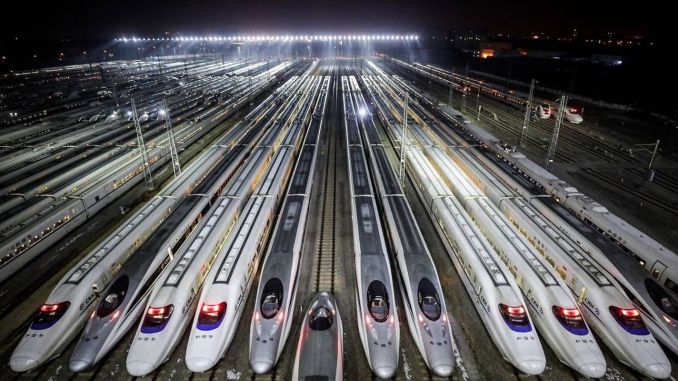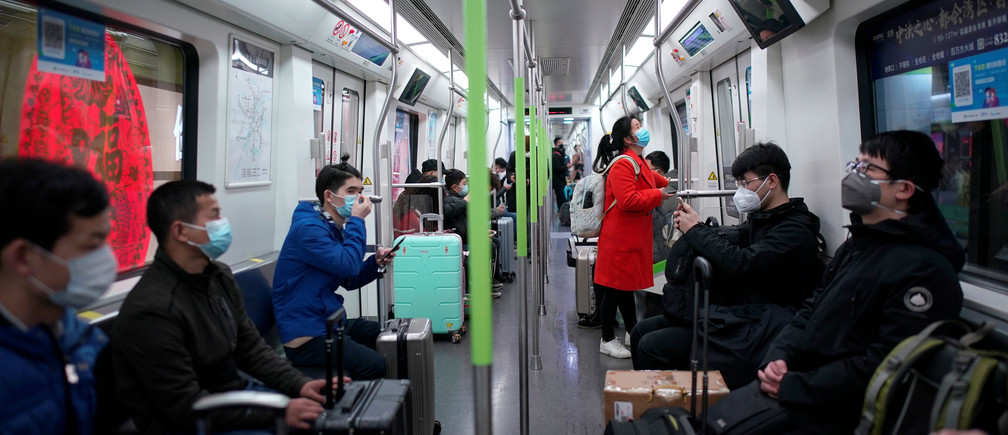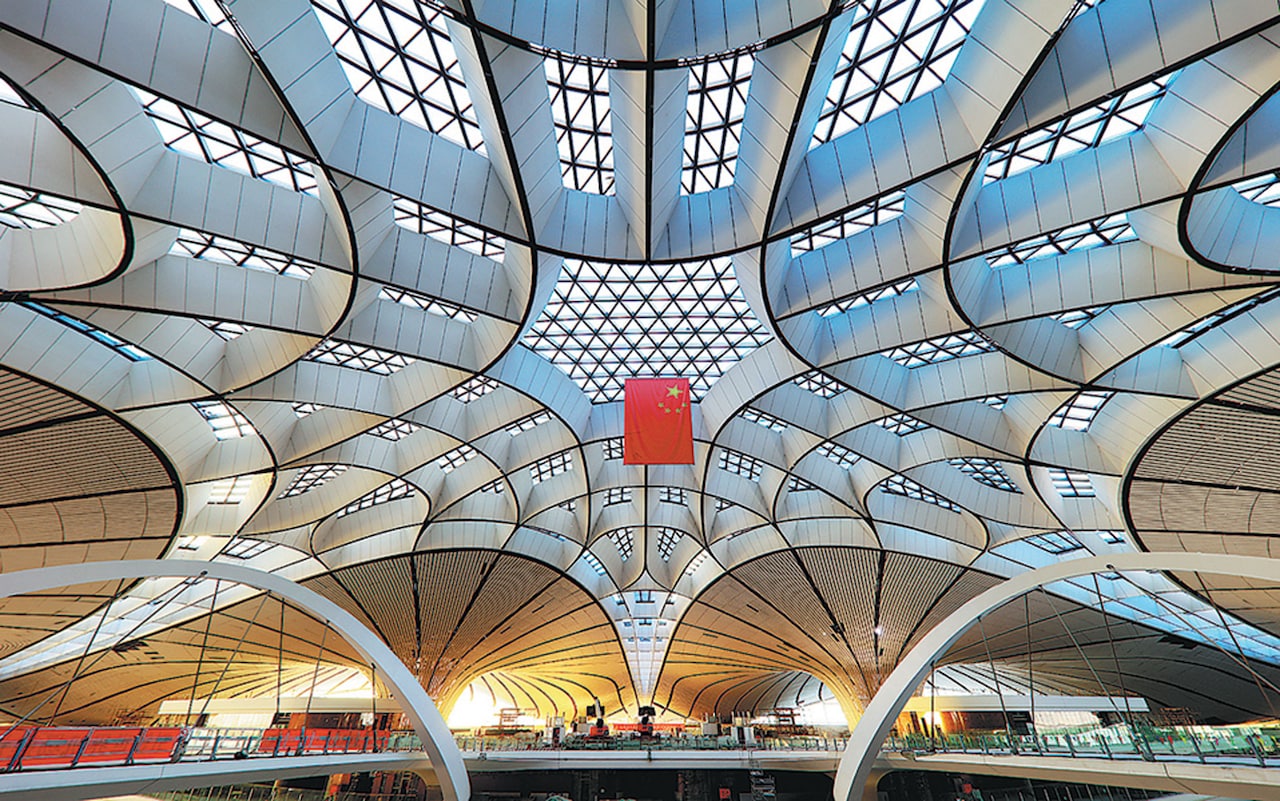China’s Transportation in the Post-Pandemic Era
February 28, 2022
About the author:
Zhang Zhuting, Senior Fellow of Taihe Institute; Director at the Development Research Center of Transport Management Institute, Ministry of Transport of the People’s Republic of China
China’s society and economy have entered a new stage of development after two years of fighting the pandemic, thanks largely to the transportation industry that has withstood the many challenges posed by the virus and has further advanced its services by routinizing the effective practices of preventing the spread of COVID-19 in the years of 2020 and 2021.
(Source: www.raillynews.com)
Back in September 2019, China announced the goal of developing “three networks and two circles” as part of its effort to become a transportation power. Specifically, there would be a developed fast network, a sound trunk network, and an extensive basic network coupled with a “national one-two-three transportation circle,” namely one-hour commute in urban areas, two-hour travel between the cities of a conurbation, and three-hour reachability of major cities nationwide, as well as a “global one-two-three express cargo flow circle,” which refers to one-day delivery in China, two-day delivery in neighboring countries, and three-day delivery in major cities in the world. At the initial stage of the pandemic outbreak, many thought that there would be no way of achieving such a goal as everything came to a stop. Yet, quite the contrary, the advance of China’s transportation turned out to be unstoppable.
A salient example is the transportation infrastructure developed for the 2022 Winter Olympics. The Olympics was staged across three zones with a maximum distance of nearly 200 kilometers. Before and during the Games, relevant personnel and equipment were moving non-stop between these zones by intercity high-speed railway, intra-city railway, and expressway. At least some of the Olympic-related infrastructure were newly built, expanded, or renovated during the pandemic. This was not trivial. We could hardly imagine that traveling from Qinghe (Beijing) to Taizicheng (Zhangjiakou)—a distance of about 180 kilometers apart—would take less than an hour, and from Qinghe to Yanqing, which are around 65 kilometers apart, only 26 minutes. Even better, 5G live-streaming of the Olympic Games was available on the Beijing-Zhangjiakou bullet trains.
There is no doubt that the COVID-19 outbreak posed a serious challenge to China’s transportation industry. On the one hand, it was a major source of imported cases. On the other hand, it played a significant role in sustaining and driving China’s socio-economic development. Due to the pandemic, international flights were forced to suspend their operations for times. Domestic high-speed rail and road transportation were also impacted to varying degrees. This can be seen in the Spring Festival travel rush, which is an annual barometer of China’s transportation situation. Between 2019 and 2021, the number of trips made during the 40 days of the holiday season fell from 2.98 billion to 1.48 billion to 0.87 billion. While Chinese people are becoming more accustomed to the idea of “staying put during the Spring Festival,” the transportation industry severely suffered.
(Source: www.weforum.org)
Despite these losses, the Chinese central government and the transportation authorities quickly proposed and implemented a series of measures to contain the spread of the virus and maintain the functioning of the economy. For example, policies and measures were put in place to block the transmission channels of the virus while guaranteeing the operation of highway networks, channels for emergency transportation, and passageways, which were key to delivering daily necessities and work supplies to the masses.
A “Three Nos and One Priority” measure was also carried out to ensure that vehicles for emergency supplies and personnel transportation would not be “stopped, checked, or tolled,” and that emergency transportation vessels would be the first to pass through the lock, get piloted, drop, or lift anchor, etc. Therefore, the measure was also widely known as the “anti-epidemic green channel policy.”
As the fight against COVID-19 dragged on, the authorities accordingly adjusted the existing transportation policies and introduced what they termed as opening up the “arteries,” smoothing the “capillaries,” and promoting “dual circulation.” Opening up the “arteries” means customizing the cross-district transportation routes for anti-epidemic supplies and laborers to return to their work, coordinating the prompt issuance of a single “safe-conduct,” and helping enterprises that have already resumed operations or are ready to resume operations take necessary precautions, amass adequate supplies, and have sufficient staff on duty.
Smoothing the “capillaries” means resuming urban public transportation in an orderly manner through better coordinating bus and cab capacity, offering “point-to-point” transportation services, and making it easier for distribution vehicles to enter the destination cities and find temporary parking, so as to solve the hiccups in the first and last-kilometer of delivery and meet the urban logistics needs to the fullest extent possible.
Promoting the “dual circulation” means leveraging the industry’s role in the country’s efforts to establish a development pattern in which the domestic economic cycle plays a leading part while the international economic cycle maintains its extension and supplements the domestic development cycle. Meanwhile, the transportation industry has a decisive role to play in building high-quality BRI (Belt and Road Initiative) projects, facilitating exports and imports, and maintaining the security and stability of industrial and supply chains.
Looking back at the past two years, the transportation industry has been taking pains to prevent COVID-19 from entering the country and causing new waves of outbreaks. Despite the many suspension orders that have been issued in 2020 and 2021, on February 15, 2022, the Civil Aviation Administration of China (CAAC) issued another one for two routes: one from Tehran to Guangzhou, and the other from Abu Dhabi to Shanghai.
According to the Frontier Health and Quarantine Law, the Emergency Response Law, and the Civil Aviation Law, the CAAC will issue suspension orders for an airline’s operations along a specific route under two circumstances. First, if five to nine passengers on a single flight along the route are found positive in their COVID tests after arrival, then the airline along the route will be suspended for one week. Second, if the number of such passengers reaches ten, the airline along the route will be suspended for four weeks. After the end of the suspension period, the airline may resume one flight per week along the route.
Transportation can contain, as well as catalyze, the spread of the virus. It all depends on how effectively the anti-epidemic rules are formulated and implemented. The current rules include the Technical Guideline on COVID-19 Prevention, Control and Disinfection for Imported Cold Chain Food Logistics Through Highway and Waterway (Third Edition), the Guidance on the Prevention and Control of COVID-19 for Ports and Its Front Line Staff (Eighth Edition), the Guidance on Multi-Zone, Multi-Level Prevention and Control of COVID-19 for Passenger Stations and Means of Transportation (Sixth Edition), and the Guidance on the Prevention and Control of COVID-19 for Highway Service Areas and Toll Stations (Fourth Edition). These rules and regulations have been constantly revised in response to the changing situation, from the Wuhan lockdown to today’s traffic control for medium and high-risk areas as well as the suspension orders for international airlines. All this has facilitated the integration of the preventive mechanisms and the whole Chinese transportation system.
During the trying times of the past two years, new technologies and new infrastructure also figured prominently in the fight against COVID-19. Online freight operators and express delivery companies were able to use UAVs (Unmanned Aerial Vehicles), USVs (Unmanned Surface Vehicles), and UGVs (Unmanned Ground Vehicles) for contactless urban delivery, linking the supply side directly with the demand side. Web-based car-hailing and bike-renting have also satisfied mobility needs while putting idle capacity to good use.
From a mid-term development perspective, infrastructure projects, especially the new ones, are to contribute immensely to China’s economic development. The Ministry of Transport is expecting significant achievements in the construction of IT-enabled and other types of new transportation infrastructure by 2035, thus increasing precision in sensing, analytics, management, and services. If all goes well as planned, new infrastructure will be able to fast-track China towards a transportation power. In the meantime, infrastructure is going greener and smarter. Ubiquitous sensing facilities, advanced transmission networks, and spatial and temporal information services provided by such systems as Beidou have found wide applications for the transportation industry. Meanwhile, as industry data centers and network security systems have taken shape, smart trains, vehicles, and vessels are hitting the market. Innovation is further asserting itself as a foundational driving force in China’s transportation industry as China becomes the world’s leader in forward-looking technical applications. Some of these technologies and infrastructure have already proved their worth during the Beijing Winter Olympics transportation services.
Among countries around the globe, China has succeeded in building the largest high-speed railway and expressway networks across its vast land, as well as a cluster—unparalleled in size—of world-class ports. The country is also connected to all parts of the world by air and by sea. Its comprehensive transportation network now extends more than six million kilometers.
Furthermore, China has made great breakthroughs in equipment manufacturing. Not only is the country building its own bullet trains and large passenger aircraft but it also produces over half of the world’s new energy vehicles. Some of its mega-transportation projects have come into operation, including the Hong Kong-Zhuhai-Macao Bridge and the Beijing Daxing International Airport.
(Source: www.telegraph.co.uk)
In addition, among the leading global economies, China comes out top in maritime connectivity and the volume of trade in goods. During the COVID-19 pandemic, the China-Europe Railway Express and ocean-going cargo vessels have been running day and night to keep global industrial and supply chains as stable as best they can.
In his keynote speech at the second United Nations Global Sustainable Transport Conference that was held in Beijing on October 14, 2021, Chinese President Xi Jinping likened the transportation industry as “a frontier in China’s modernization drive.” The strategic positioning of transportation and its relevance in the new era of development has since been encouraging and inspirational to the industry. It is thus reasonable to believe that China’s transportation will make more and greater contributions not just to the country’s post-pandemic modernization but to the global socio-economic advancement as well.
This article is from the February issue of TI Observer (TIO), which is a monthly publication devoted to bringing China and the rest of the world closer together by facilitating mutual understanding and promoting exchanges of views. If you are interested in knowing more about the February issue, please click here:
——————————————
ON TIMES WE FOCUS.
Should you have any questions, please contact us at public@taiheglobal.org


